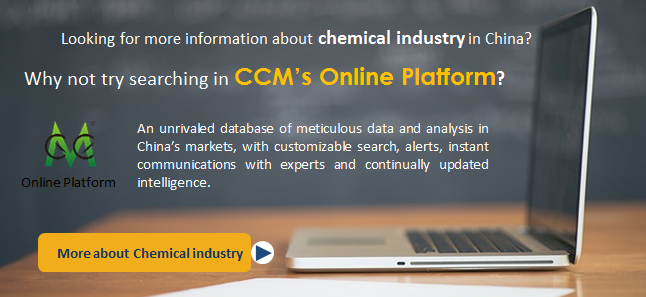According to the National Bureau of Statistics of China, in 2015, except for
the 4.8% year-on-year decline in the output of caustic soda and the output of
pesticide technical remained the same as that in 2014, the output of other
products all increased. In particular, plastics in primary shape, chemical fertilizers and chemical fibers witnessed a big growth in the output, with the
growth rates of 10.7%, 10.0% and 9.9% respectively.
The domestic chemical industry was haunted by four problems.
Weak investment
The fixed assets investment in the chemical industry was slowing down in 2015,
with a growth rate decline of 5.5 percentage points compared to 2014. In
chemicals and chemical products and manufacturing, the fixed assets investment
increased by 2.8% year on year, with the growth rate decline of 7.8 percentage
points.
In medical manufacturing, the fixed assets investment was up 11.7%,
with the growth rate decrease of 3.3 percentage points. In rubber and plastic
manufacturing, the fixed assets investment went up 10.4%, with the growth rate
decrease of 2.5 percentage points. In chemical fiber manufacturing, the fixed
assets investment went up 2.9%, with the growth rate decrease of 2.1 percentage
points.
Compulsory limitation on production capacity by the Chinese government
During the period of the Thirteenth Five-year Plan, the number of the pesticide
industrial enterprises shall decrease by 30% and the production capacity of
phosphate shall be limited under 24 million t/a. The Plan of Zero Growth in
Chemical Fertilizers Consumption and the Plan of Zero Growth in Pesticide
Consumption released by the Ministry of Agriculture pointed out that in 2020,
the goal of zero growth in both chemical fertilizers and pesticides shall be
achieved.
Later on, the Ministry of Industry and Information Technology stated
clearly that no new pesticide manufacturers shall be registered. In addition,
the overcapacity in the industries of chlor-alkali, chemical fibers, tires
and inorganic chemicals are becoming more and more serious. The Chinese
government is putting efforts in limiting the production capacity.

Heavier taxation
The total taxes on chemical industry were up about 5.1% with less than 2%
growth in revenue, while the total taxes on the whole secondary industry in
China only increased by 3.1%. The heavy taxation had greatly influenced the
re-productivity and competitiveness of the chemical industry and had put a
quite some of enterprises into manufacturing difficulties.
According to
the Notice of Recharging Value Added Tax on Chemical Fertilizers, it
stated that: since 1 Sept., 2015, the chemical fertilizers sold and imported
shall be charged the value added tax with the tax rate of 13%. In the
meanwhile, the charge-then-return policy of value added tax
on potassic fertilizers shall halt.
Increasing manufacturing costs
Though the prices of petrol and some chemicals had decreased, the costs of
labor, fund-raising, logistic, environmental issues and electricity had been
going up. In 2015, the chemical industry should pay RMB87 for the
cost in its RMB100 revenue, which was RMB1.32 higher than that
in the whole secondary industry in China. The lower profit had led to weak
market and weak investments in manufacturing.
This article comes from Phosphorus Industry China Monthly Report 1602, CCM

About CCM:
CCM is the leading market
intelligence provider for China's agriculture, chemicals, food &
ingredients and life science markets. Founded in 2001, CCM offers a range of
data and content solutions, from price and trade data to industry newsletters
and customized market research reports. Our clients include Monsanto, DuPont,
Shell, Bayer, and Syngenta. CCM is a brand of Kcomber Inc.
For more
information about CCM, please visit www.cnchemicals.com or get in touch with us directly by emailing econtact@cnchemicals.com or calling +86-20-37616606.
Tag: chemical